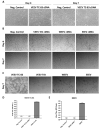Inactivation of Venezuelan Equine Encephalitis Virus Genome Using Two Methods
- PMID: 35215864
- PMCID: PMC8878209
- DOI: 10.3390/v14020272
Inactivation of Venezuelan Equine Encephalitis Virus Genome Using Two Methods
Abstract
Venezuelan equine encephalitis virus (VEEV) is an Alphavirus in the Togaviridae family of positive-strand RNA viruses. The viral genome of positive-strand RNA viruses is infectious, as it produces infectious virus upon introduction into a cell. VEEV is a select agent and samples containing viral RNA are subject to additional regulations due to their infectious nature. Therefore, RNA isolated from cells infected with BSL-3 select agent strains of VEEV or other positive-strand viruses must be inactivated before removal from high-containment laboratories. In this study, we tested the inactivation of the viral genome after RNA fragmentation or cDNA synthesis, using the Trinidad Donkey and TC-83 strains of VEEV. We successfully inactivated VEEV genomic RNA utilizing these two protocols. Our cDNA synthesis method also inactivated the genomic RNA of eastern and western equine encephalitis viruses (EEEV and WEEV). We also tested whether the purified VEEV genomic RNA can produce infectious virions in the absence of transfection. Our result showed the inability of the viral genome to cause infection without being transfected into the cells. Overall, this work introduces RNA fragmentation and cDNA synthesis as reliable methods for the inactivation of samples containing the genomes of positive-strand RNA viruses.
Keywords: RNA fragmentation; Venezuelan equine encephalitis virus; cDNA synthesis; encephalitis; viral genome inactivation.
Conflict of interest statement
The authors declare no conflict of interest. The funders had no role in the design of the study; in the collection, analyses, or interpretation of data; in the writing of the manuscript, or in the decision to publish the results.
Figures






Similar articles
-
A Quantitative Real-Time RT-PCR Assay for the Detection of Venezuelan equine encephalitis virus Utilizing a Universal Alphavirus Control RNA.Biomed Res Int. 2016;2016:8543204. doi: 10.1155/2016/8543204. Epub 2016 Nov 29. Biomed Res Int. 2016. PMID: 28042576 Free PMC article.
-
Ablation of Programmed -1 Ribosomal Frameshifting in Venezuelan Equine Encephalitis Virus Results in Attenuated Neuropathogenicity.J Virol. 2017 Jan 18;91(3):e01766-16. doi: 10.1128/JVI.01766-16. Print 2017 Feb 1. J Virol. 2017. PMID: 27852852 Free PMC article.
-
Venezuelan and western equine encephalitis virus E1 liposome antigen nucleic acid complexes protect mice from lethal challenge with multiple alphaviruses.Virology. 2016 Dec;499:30-39. doi: 10.1016/j.virol.2016.08.023. Epub 2016 Sep 12. Virology. 2016. PMID: 27632563 Free PMC article.
-
Venezuelan Equine Encephalitis Virus Capsid-The Clever Caper.Viruses. 2017 Sep 29;9(10):279. doi: 10.3390/v9100279. Viruses. 2017. PMID: 28961161 Free PMC article. Review.
-
Current Understanding of the Molecular Basis of Venezuelan Equine Encephalitis Virus Pathogenesis and Vaccine Development.Viruses. 2019 Feb 18;11(2):164. doi: 10.3390/v11020164. Viruses. 2019. PMID: 30781656 Free PMC article. Review.
Cited by
-
Establishment of an Inactivation Method for Ebola Virus and SARS-CoV-2 Suitable for Downstream Sequencing of Low Cell Numbers.Pathogens. 2023 Feb 17;12(2):342. doi: 10.3390/pathogens12020342. Pathogens. 2023. PMID: 36839614 Free PMC article.
-
Identification of host lncRNAs that impact Venezuelan equine encephalitis virus replication.bioRxiv [Preprint]. 2025 May 12:2025.05.12.653438. doi: 10.1101/2025.05.12.653438. bioRxiv. 2025. PMID: 40463150 Free PMC article. Preprint.
-
Formalin and 2.5% Glutaraldehyde/2% Paraformaldehyde in 0.1 M Cacodylate Buffer Inactivation Protocols to Ensure the Proper Fixation of Positive Sense RNA Viruses and Genomic Material Prior to Removal from Containment.Methods Protoc. 2024 Dec 21;7(6):105. doi: 10.3390/mps7060105. Methods Protoc. 2024. PMID: 39728625 Free PMC article.
References
-
- Payne S. Viruses. Academic Press; Cambridge, MA, USA: 2017. Introduction to RNA Viruses; pp. 97–105. - DOI
-
- Select Agents and Toxins List/Federal Select Agent Program. [(accessed on 12 September 2021)]; Available online: https://www.selectagents.gov/sat/list.htm.
-
- Guidance on the Regulation of Select Agent and Toxin Nucleic Acids: Changes/Highlights/Compliance/Federal Select Agent Program. [(accessed on 11 September 2021)]; Available online: https://www.selectagents.gov/compliance/guidance/nucleic/index.htm.
Publication types
MeSH terms
Substances
Grants and funding
LinkOut - more resources
Full Text Sources

